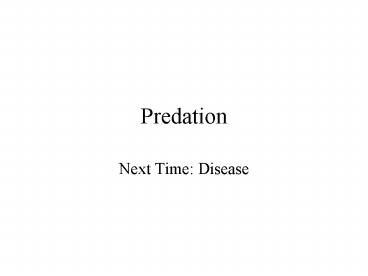Predation - PowerPoint PPT Presentation
1 / 23
Title: Predation
1
Predation
- Next Time Disease
2
Predation
- Management of predators - emotionally charged
topic - Poor experiments
- Topic of long-term debate
3
Terminology
- Predators Animals killing and eating other live
animals - Scavengers Animals that eat animals that are
already dead - 5 types of predators
- Carnivore kills and eats animal prey
- Insectivore
- Herbivore consumes living green plants and
seeds - Cannibalism eats and kills animals of same
species - Compensatory predation - prey without access to
habitat (cover) are more vulnerable to predation - Non-compensatory predation related to prey
density not habitat - Additive and Compensatory Mortality
4
Predator-Prey Relationships
- Response of Predators to Prey Density
- Functional Response how behavior of predator
changes with prey densities - Search patterns, appetite, and handling time
- Numerical Response how population processes of
predators changes with prey densities - Survival, Reproduction, and Movement
- Total Response Combined Functional and
Numerical - Number of prey eaten per predator x predator
density prey mortality rate
5
(No Transcript)
6
(No Transcript)
7
(No Transcript)
8
(No Transcript)
9
(No Transcript)
10
Features of Total Response
- Number of prey eaten per predator x predator
density prey mortality rate - Predation can regulate prey density only with a
type III functional response because - Only type of response that allows prey mortality
rate to increase with prey density - Regulation limited to interval where mortality
rate increases (line below the linear line in
Type I response) predator pit - If prey exceeds limit of this interval, mortality
due to predation declines, and prey growth will
be regulated by other factors escape from
natural enemies
11
(No Transcript)
12
- Prey mortality rate initially increases with
increase in prey density - Can prey reach densities to escape predator
pit?
Prey Mortality Rate
13
Effects of Predation on Prey
- Limiting Factor Density-dependent and
independent factors that limit change (l)of prey - Regulating Factor Density-dependent factor
- All factors can be limiting, only those that are
density-dependent can be regulating
14
Predator-Prey Models
- Lotka-Volterra
- Constant food supply for prey
- Constant effects of disease and other predation
on prey - Decline in predator populations in absence of
prey - Recurrent Fluctuation Model
- Used for Moose and Predators
- Predators as regulator factor
- Tanana Flats, Kenai
15
Can you recognize the pit and the escape from
predation.
16
Low Density Equilibrium Model
- Prey never escapes predator pit fully
- Denali, Isle Royale
17
Multiple Equilibrium Model
18
Predator Control
19
(No Transcript)
20
(No Transcript)
21
(No Transcript)
22
(No Transcript)
23
(No Transcript)































